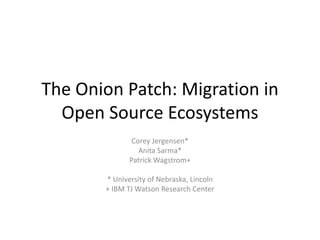The Onion Patch: Migration in Open Source Ecosystems
- 1. The Onion Patch: Migration in Open Source EcosystemsCorey Jergensen*Anita Sarma*Patrick Wagstrom+* University of Nebraska, Lincoln + IBM TJ Watson Research Center
- 2. 2Not sure if this a paper aboutogres, software development,or cookingSeptember 7, 2011
- 3. This Talk in One şÝşÝߣThe Onion Model proposed a model for developers to join individual projectsEcosystems change the project landscapeSimilar social norms and technical requirements across projects in an ecosystem lower barrier to entryWe examine how an ecosystem alters the ways in which developers join projects3September 7, 2011
- 4. Spoiler Alert ¨C Our FindingsThere are different progression paths that can be followedTenure does not necessarily mean more central contributionDifferent Classes of Committers ExistLittle concrete evidence of the Onion model4September 7, 2011
- 5. OverviewThe Onion ModelPrimary Research QuestionsOur dataProgression pathsEffect of tenure on commit centralityCommitter classesImplications5September 7, 2011
- 6. Layers ¨C Like an OnionUsersSocialMailing ListsContributorsSocio-TechnicalBug TrackersCoreCodeTechnical6September 7, 2011
- 7. Research QuestionsDoes Migration Occur in Ecosystems?When a developer migrates, can they kickstart participation with pre-existing knowledge?In interconnected ecosystems, what factors affect contribution type and quality?7September 7, 2011
- 8. The GNOME ProjectWe examined subset of six successful projectsBetween 369 and 1085 people active across email, bug tracker, and code repositoryBoth GUI tools and underlying librariesUp to 10 years of history8September 7, 2011
- 9. Does Migration Exist?September 7, 20119716541122120169162123369475181691641331661076901085112
- 10. Progression Paths10Release 2Release 1Release 3BugsCodeMailSocio TechnicalCodeMailBugsAcceleratedMailCodeBugsTechSocialCodeBugsTechnicalCodeSource OnlySeptember 7, 2011
- 11. Findings of Progression Paths - Project11September 7, 2011
- 12. Findings of Progression Paths - Ecosystem12September 7, 2011
- 13. Centrality of CommitsDifference between being a committer and being a core committerPrevious research has shown that core does most of the work on most projectsOnce becoming a committer, what factors affect relationship to core?13September 7, 2011
- 14. Commit 1Calculating Source Code Centrality14foo.cbar.cCommit 2baaz.cAlicequux.cBobSeptember 7, 2011
- 15. CentralityTimeTenure != CentralitySimple StoryMail Activity +Tracker Activity +Project Experience -Detailed StoryMail Activity +Tracker Activity +New to Project +Middle Aged +Experienced ???15September 7, 2011
- 16. Major Factors Affecting Centrality16Artifacts CreatedSource Commits
- 17. Bugzilla Activity & Comments
- 18. Mailing List MessagesSingle Project ExperiencePrior Experience
- 20. Project ExperienceComponent 2Component 1Broad Social ExperienceTranslation Commits
- 22. Prior Experience
- 25. Active ExperienceTechnical Medium ExperienceSource Commits
- 26. Mailing Lists
- 27. Tracker Activity
- 28. Prior Experience
- 29. Active ExperienceComponent 3Component 4September 7, 2011
- 30. Kikezekazemberek?Translators!Common infrastructure used across projectsˇ°Parachute inˇ± to implement internationalizationIndividual translators can work only on the translation files without needing to hack project code17WersinddieseLeute?Who are these people?ËĘÇŐâĐ©ČËŁżSeptember 7, 2011
- 31. Implications?Open Source is kinda like an onion, but for the most part it isnˇŻtThere is a need for project stewards as well as code warriorsCommon Infrastructure enables ecosystem migrationEcosystems have changed our viewsWhen hiring question should not be ˇ°What have you done on project Xˇ±? Rather ˇ°Show me everything that youˇŻve done on Github.ˇ±StackExchange for example accrues karma across all boardsFor researchingIs socialization process taking place through social media?Are layers of the onion model being created outside of traditional Software Engineering artifactsIs karma/credits already known intrinsically by the community and leading to following?18September 7, 2011
Editor's Notes
- #4: Spoiler Alert: We found little evidence of the onion model in our data. We did, however, find lots of other interesting things
- #5: Remember to say that ˇ°we are scoping to some of the more novel findings in our work. Our research questions and hypotheses that drove our work can be found in the paper, along with the stats that go with it.ˇ±
- #7: Onion modelFirst socialization then technical contributionHowever, the immigration model is based on stand alone projectsToday, the norm is well-connected ecosystemsNo findings as of yet on socialization processes in an ecosystem
- #9: We have all of the code, mailing lists, and bugs for each of these projects.The people were unified across projects through a variety of methods ¨C email address was easiest. In many cases we needed to work with experts in the community to get the resolution we needed.
- #10: The centers of the circles indicate the number of developers working on the project.The lines indicate the number of developers shared between the projects.Not all lines are shown because it is a clique, and that would be a very messy and unpretty graph
- #11: After discovering that there is a significant migration we wanted to actually examine the onion model and how it works within a project and ecosystem.These are samples of the five different models of joining that we found in the system.Note, weˇŻre only looking at progression patterns of people who eventually became committers.
- #12: Notes: This only covers people who eventually became committers
- #13: Notes: This only covers people who eventually became committersNext we evaluated progressions across the ecosystem ¨C we basically looked at contributions as though everything in the ecosystem was a single projctWe start to see a trend here, but itˇŻs just across six project. If we had the data to extend it more then we might see more people fall in to the technical-social patterns
- #16: We did a simple regression that mapped together activity on the mailing lists and bug trackers to relate to commits.
- #18: ThatˇŻs Hungarian for ˇ°Who are these people?ˇ±Shu¨Şsh¨¬zh¨¨xi¨Ąr¨¦n?


















